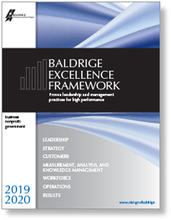Blogrige
The Official Baldrige Blog

"I have been offered a significant increase in salary by another employer and am giving my two week notice."
My guess is that this is the most common reason given when employees quit their current job. But is salary the real reason most employees quit? I have always suspected and believed that, given a fair salary, people do not quit their jobs for money. So why do they leave?
I was recently drawn to explore this topic a little more deeply after reading an article about IBM Watson's latest feat. A new, proprietary IBM AI algorithm can predict with 95% accuracy which workers are about to quit their jobs. The algorithm has been successfully deployed to predict IBM employees who are a flight risk and then to propose actions to managers to engage and retain those employees. Exploring the topic of employees quitting a little further, I discovered a recent HBR blog by Jon Christiansen. Through looking at 15 years of data, Christiansen identified eight reasons he believes employees quit.
Six Reasons Employees Look for a New Job
While I certainly don't have the data analysis capabilities of Watson or the data set from the 15-year study by Christiansen, the Baldrige Progam has given me a unique opportunity to observe organizations across all sectors for more than 25 years. I have also had the privilege of leading several organizations. Putting my own observations together with the available information from these two resources, I believe there are six common reasons for people deciding to look for new jobs. (Spoiler alert: salary is not one of them.)
- Lack of trust in your organization's leaders — What contributes to a lack of trust? A clear indication of unethical or illegal behavior is a game-ending situation for me and many other people. I want out! A lack of trust can also arise through a lack of transparency on the part of leaders or lack of follow-through on commitments they made. An unsafe work environment that is known and tolerated, or even promoted, for a belief of enhanced productivity also leads to a lack of trust.
- A toxic culture — Does the organization have a stated culture that is very different from the actual culture? Does the actual culture contradict the organization's stated values? Are there clear biases seen in the way different people are treated by leaders and managers? Are failures regularly attributed to people rather than process failures? Are people afraid to speak up? And when they do, are they ignored or ridiculed? Do leaders and managers discourage new ideas from employees? Is communication characterized as strictly top-down messaging? These are all signs of a toxic culture. One likely to result in high turnover rates.
- Lack of clear goals and expectations — Does the organization have a clear and shared vision for the future? Do people feel they have a role in achieving that vision? Does the organization have clear strategic objectives and are those objectives translated into action plans with clear links to individual employee opportunities to contribute? Do employees know what is expected of them for the next year, collectively and individually?
- Lack of meaningful work and empowerment — Does the work people do effectively utilize their skills and talents? Were the job responsibilities clearly explained when they were recruited or promoted into the job? Are employees empowered to do their jobs without unneeded supervision? Is micromanagement the cultural norm in the organization? Do employees feel in control of their own work? Can they "stop the line" if they see a problem?
- Lack of developmental opportunities — Is the organization a learning organization? Are people encouraged and supported in enhancing their skills and education? Do employees have individual development plans that are regularly discussed with their supervisors? Is career planning part of performance discussions? Are jobs with promotion potential posted internally?
- Lack of appreciation — Do supervisors, managers, and senior leaders show appreciation for employee contributions to the organization's success? Do they make a habit of saying thank you to employees? Do they send written notes of appreciation for a job well done to employees (and maybe their families as well)? Is there an easily implemented mechanism for peer-to-peer recognition? Does the organization feel like a family or a collection of hired hands?
What Can Your Organization Do to Retain Employees?
Does your organization need a systemic approach to addressing these employee engagement shortcomings? The criteria questions in the Baldrige Excellence Framework and the summary questions in the introductory Baldrige Excellence Builder can help you address these opportunities for improvement in a holistic manner. Address them successfully and the organization could become a role model for employee engagement and retention.
Specific questions in the Leadership (category 1), Strategy (category 2), and Workforce (category 5) sections will help you not only address the topics but do it in the context of everything else that is important to your organization.
Share Your Best Practices
Please let me know if you have a noteworthy practice for employee engagement and retention in use in your organization!

Baldrige Excellence Framework
The Baldrige Excellence Framework has empowered organizations to accomplish their missions, improve results, and become more competitive. It includes the Criteria for Performance Excellence, core values and concepts, and guidelines for evaluating your processes and results.
Purchase your copy today!
Available versions: Business/Nonprofit, Education, and Health Care





